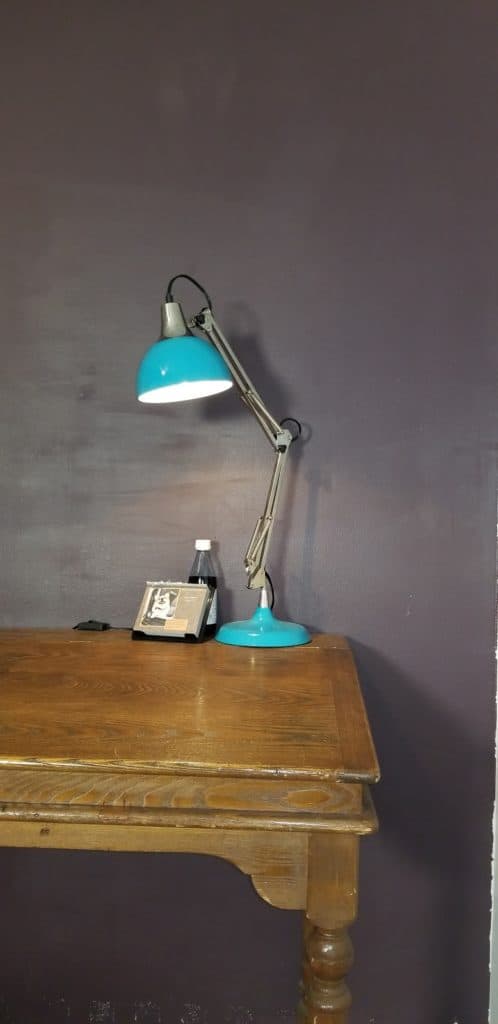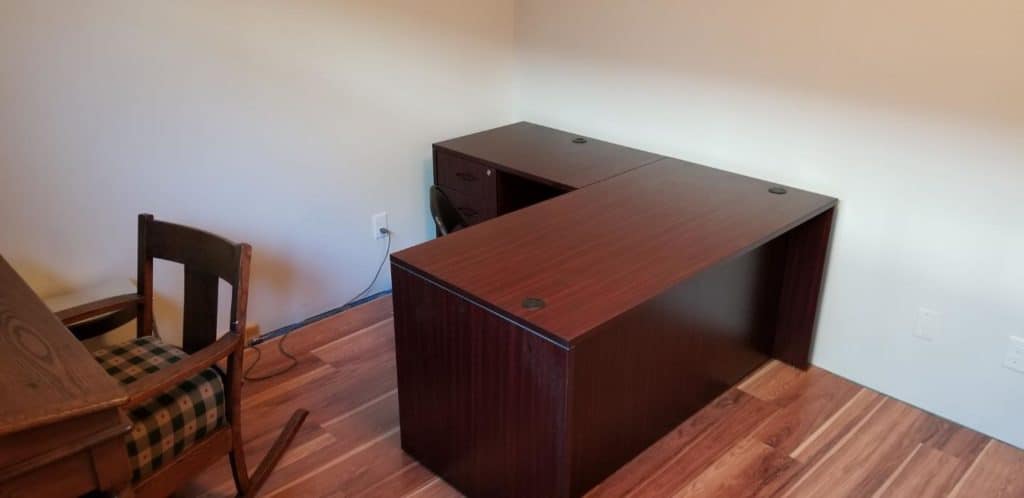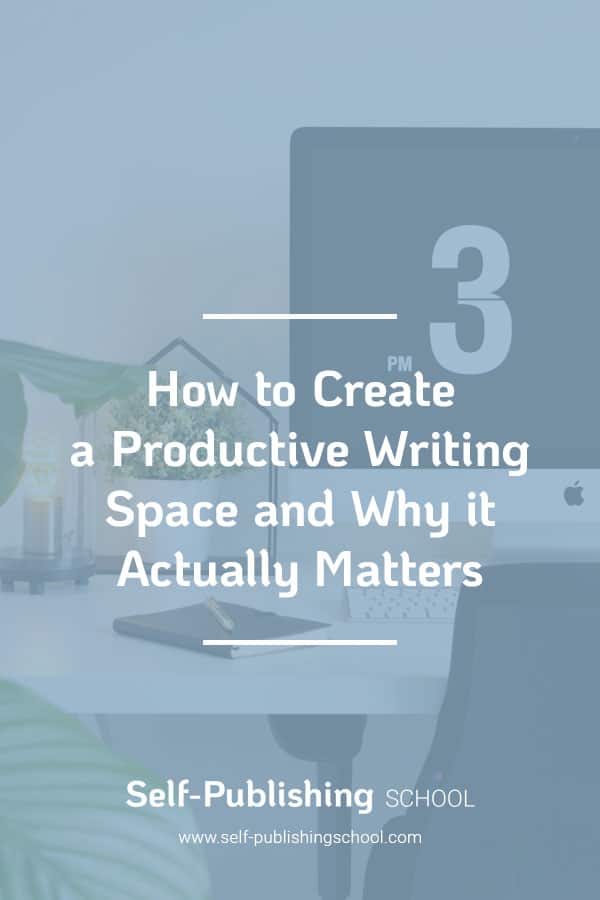You know that writers write…but did you know your writing spaces matters significantly?
You’re a writer when you put your pen on your paper and create words that combine together to form a sentence. You’re a writer when you stroke the keyboard and type out an email. You’re a writer when you comment on a Facebook post.
The fact is, you’re a writer whenever and wherever you add anything in writing in a physical or virtual location—but especially if you’re writing a book.
But where should you write? What makes a great writing space? And how do you create one?
Here’s what we’ll cover about writing spaces:
- Why dedicated writing spaces help
- Step-by-step guide to creating a writing space
- Writing spaces at home
- Writing spaces outside of the house
- Writing space mistakes to avoid
- Where to write
- Utilize at-home writing spaces always
- Block out noise with headphones
- Set a timer in your writing space
- Write in the same place
- Writing space tips from famous authors
Read on, my friend.
You’re going to learn about my favorite writing spaces and tools for where to write and creating a writing space.
Why dedicated writing spaces help you do your best work
So why should you take the time to establish dedicated writing spaces? Here are some of the major benefits:
- Boosts Concentration: Ever noticed how you just seem to write better in certain places? Well, that’s no fluke. A dedicated writing space, free from distractions, can significantly enhance your concentration, making it easier to dive into the depths of your creativity.
- Sets a Routine: Just like you have a specific place for eating or sleeping, a designated writing space helps establish a consistent writing routine. When you consistently write in the same place, your brain begins to associate that space with writing. So, every time you sit down in your writing space, your brain automatically switches to writing mode—pretty neat, huh?
- Fosters Discipline: Discipline is what separates writers who write from those who just think about writing. Having a writing space can bolster your discipline by signaling a clear intention to write whenever you enter that space. It’s a physical reminder that it’s time to do what writers do best—write.
- Encourages Organization: Do you often find yourself misplacing your notes or forgetting where you saved that crucial chapter outline? Having a dedicated writing space allows you to keep all your writing tools and materials in one place. This means less time spent hunting for lost items and more time for the important stuff—writing.
- Inspires Creativity: Surrounding yourself with objects that inspire you can unleash your creativity. In your writing space, you can display favorite books, quotes, or images that spark ideas. It’s like having your personal source of inspiration that fuels your writing.
- Promotes Mindfulness: Ever had your writing interrupted by a loud TV, a chatty neighbor, or a needy pet? Your writing space can be your sanctuary, a place where you can block out the outside world and focus solely on your writing. It’s your bubble of calm in a chaotic world—your haven for undisturbed writing.
- Improves Productivity: And finally, a well-organized writing space can greatly boost your productivity. By eliminating distractions and providing a comfortable environment, it allows you to write more efficiently and effectively. So, whether you’re racing against a deadline or just trying to beat your personal best, your writing space is your secret weapon.
Your step-by-step guide on how to set up a writing space

So how do you go about establishing a writing space that meets your needs? Here’s a useful step-by-step guide to get it done.
Step 1 – Identify Your Needs
First off, figure out what you need in a writing space. Do you need silence, or do you thrive with some background noise? Identifying your needs is the first step to finding the perfect writing space.
Step 2 – Consider Comfort
Now, think about physical comfort. Choose a chair that’s comfortable and a desk that’s the right height—trust me, your back will thank you later.
Step 3 – Check the Lighting:
Check out the lighting situation. Remember, good lighting is crucial to avoid eyestrain, so make sure there’s enough natural light and supplement with artificial lighting if necessary.
Step 4 – Evaluate Noise Levels:
Evaluate the noise level of potential spaces. Remember, too much noise can be distracting, so try to choose a quiet space where you won’t be disturbed.
Step 5 – Ensure Privacy:
A private space can help you focus better. Make sure your chosen space offers enough privacy for uninterrupted writing—remember, you want to write, not chat with every passerby.
Step 6 – Prioritize Organization:
Prioritize a space where you can keep all your writing materials organized. It’s much easier to stay focused when your space is tidy and everything you need is within reach.
Step 7 = Add Personal Touches:
Add personal touches to your space. This could be anything from a favorite piece of artwork to a cherished photo—anything that makes the space feel uniquely yours and inspires creativity.
Step 8 – Test It Out:
Now, test out your potential space. Spend a few hours writing there and see how it feels. You’ll soon know if it’s the right fit for you.
Step 9 – Make Adjustments:
Finally, don’t be afraid to make adjustments. If something isn’t working, change it. Remember, the key is to create a space where you feel comfortable and inspired to write.
And there you have it, a handy guide on how to choose a writing space. So, go forth and find your perfect writing sanctuary!
Writing spaces at home
Creating a writing space at home is not difficult and can generally be done without spending a lot of money. I am lucky enough to have my own writing office, but even without that, you can still create a space that is just for you and your writing.
Here are a few tips to start building your writing space:
- Clear off the corner of your table. (It might mean that you throw away the mountain of mail you’ve been meaning to open or you finally put your laundry away, but a corner of a table will do just fine for this).
- Find a paper and pencil, pen and notepad, or a computer.
- Put your tools in that space and you’ve built a writing space.
- Tell your kids, your significant other, or your cat (although best of luck on training the feline) that this is your space and it is protected in a magical bubble where only you are allowed!
Now, you have a writing space – where you can do what writers do, write.
If you have a small budget (less than $100) to set up a writing space, you can scour buy, sell, trade groups for small writing desks. My husband found this gem of a writing desk for $75 on a local Facebook swap site.
Once my morning brain dumping to my journal is finished, I often transition to a more standard office desk where I have my computer set up.
So if your budget is a little higher, between $300 – $500, you can buy an office desk from a used furniture store and get a nice desk, with delivery and set-up.

This helps you feel like you’re in more of a work mode and will be able to get things done

Perhaps you have a grand budget to use. You can go to a higher-end furniture store and buy a cherry or an oak desk for $1000-$2000. But, it is absolutely not necessary.
So, if you have have as little as $0 or as much as $2000+ dollars to spend, you can set up a writing space at home for you to meet your daily writing goals.
Where to write outside of your home

Anywhere!
Really, anywhere? Sure, you can go anywhere to write. I have some places that I recommend and some places that I would stay away from, but you can write anywhere.
Most writers have a favorite coffee shop. I have three. I love writing at a chain coffee shop when I need a little more background noise. It helps me zone into my rough draft writing and I work well when I am surrounded by others, coffee in hand, and can dedicate my time to writing. There’s also an independent coffee shop that I enjoy going to.
During NaNoWriMo we had some of our write-ins there. I love that it was designed so that at any table there is a spot where we can plug in our devices and type away.
I find this particularly useful when I am needing some motivation from being around other creatives, as there’s also a wall of art that changes frequently.
Finally, I really like a pay-it-forward cafe that has a community table where I can go when I need to concentrate on editing. Sometimes the different niches help me out the most so that I can focus on doing what writers do – write!
Here are some ideas for writing spaces outside our home:
- The library
- A museum
- A park
- A diner
- Your backyard
- Your front or back porch
It will depend on what you’re writing though as to which works the best.
Anywhere that you can go with your notebook, computer, or your phone is a location that you can write.
So, there you have it! You can write anywhere that you can take a writing device.
These are my overall recommended writing spaces:
- An area of your home, dedicated to writing
- A local coffee shop
- A library
- A Museum
- A park
- A shared office
- The beach
- A friend’s house
- A diner
- Anywhere that you can take a writing device
Writing space mistakes to avoid
Of course, knowing what to look for in a writing space is only part of the puzzle. It’s also worth ensuring you avoid major mistakes that will make your writing space more of a hinderance than a help. Here are some things to be aware of:
- Ignoring Comfort: Ever tried writing while perched on an uncomfortable chair or squinting at a screen that’s too far away? It’s no fun, right? One of the biggest mistakes is neglecting comfort in your writing space—always choose a chair that’s comfortable and a desk that’s at the right height to maintain a good posture.
- Overlooking Lighting: Writing in poor light is a recipe for eyestrain and headaches. Don’t make the mistake of undervaluing the importance of good lighting—both natural and artificial—in your writing space. Remember, your eyes are valuable tools for a writer, so treat them kindly.
- Choosing a Noisy Environment: Can you concentrate on writing with a TV blaring in the background or people chattering away? Probably not. Avoid selecting a writing space with constant noise distractions—it’s tough to craft a compelling narrative when you can’t even hear yourself think.
- Being Disorganized: A cluttered space equals a cluttered mind. Don’t fall into the trap of allowing your writing space to become a mess. Keep it tidy and organized so your focus stays on your writing, not on finding that lost notebook.
- Not Personalizing Your Space: Remember, your writing space should inspire you, not bore you. Avoid the mistake of not adding personal touches that inspire and motivate you. Decorate your space with items that spark your creativity and make you excited to write.
Which online writing spaces to use
On a notebook, a computer, a phone. Anywhere that you can record words and be a writer. Because that’s what a good writer does, you write.
There are many different writing software options to use for your virtual writing space.
Personally, I prefer to outline, mindmap, prewrite with a good old-fashioned pen and paper. But I know many writers who prefer to do their prewriting in a Google Doc, on Scrivener, Microsoft Office 365 or in a similar space online.
Be sure that no matter where you decide to write that you are free from distractions and that you write.
Once you have your prewriting done, then you can move into creating a first draft.
Google Docs
This is when I generally switch over from pencil and paper to an electronic format. I open up my Google Doc and I make an electronic version of my outline. This is important, because then I can quickly move from place to place in my document.
After I outline on my Google Doc, I move into writing out sentences. At this point, I don’t necessarily worry about whether or not I am writing cohesive sentences, I just get words on the paper, because I am doing what writers do—they write.
As Ray Bradbury says, “Quantity makes up for quality.”
Microsoft Word
If you’re not a Google Docs person, there are other tools out there that you can use to capture your words electronically.
The most well-known is Microsoft Word.
This is great if you always have access to it, which is possible with Office 365, but for me, Google Docs works better.
Scrivener
Scrivener is another tool that you can use to capture all your ideas, outlines, and planning in one place. The best thing about this is that it’s web-based, so you access it anywhere that you have access to the internet. Most writers that use this tool absolutely love it—so let us know if you have it and you love it.
Finally, if you’re driving and have ideas come to you, you can capture them with a speech-to-text app and then transfer them to a word processing document later.
This is particularly useful, as I often have ideas come to me when I am traveling.
Do not let the excuse of “I don’t have a writing space” hold you back from writing, because with very few tools (most are free or minimal cost), you have a writing space or a location to write.
Writing spaces tips for beginners
Setting up a writing space is not always easy, but you know you want to write and you need to have a space to do what writers do: write!
So here are some tips to help you.
1 – Use your at-home writing space for writing
You wouldn’t take a bath in the kitchen sink, right?
Right! Don’t use your writing space for other activities – only use it for writing.
“But I only have one computer – where else do I go to get on Facebook, watch YouTube, or pay my bills?”
I am guessing that if you’re like my family, you have a mobile computer – a laptop, a surface, an iPAD, or something similar. For the purpose of writing at-home, make sure that the device goes to the designated spot you have set up for that.
Then move when you’re not writing.

When we move to specific places to accomplish a task, our brains engage in those tasks and we are able to focus on doing what writers do – write.
2 – Block out noise with headphones

You will be distracted. If you’re writing at home and have children, your kids will distract you. If you’re writing at a coffee shop, there will be other customers (hey, you want coffee shops to have customers – that’s what keeps them in business and gives you a space to write).
Invest in some headphones. Our brains can process doing other things with music – or white background noise. Create some by tuning into your favorite playlist.
I personally find meditation music especially helpful for this.
3 – Set a timer
Equip your writing space with a timer. I, personally, usually have enough self-discipline to use my phone as a timer, but I love my Google Home Mini for this too.
Simply say, “Hey Google – Set timer for 25 minutes.” Twenty-five minutes is my magic number to get a lot of words written in a relatively short amount of time.
4 – Write in the same place, at the same time
Whether you write as a part of your morning writing routine, when you get home from work, or some other time of day, write in the same place at the same time.
That’s why it’s important for you to have some kind of writing space – even if it’s only the corner of the table.
5 – Write when inspiration hits too
Keep a dedicated writing space, but don’t forget about diving into the spontaneity of writing also.
That’s why I keep my Google Doc app on my phone.
I can make brief notes and then splice them together into coherent sentences later.
Writing space tips from famous authors
The advice from almost any best-selling author is to always be ready to write – anywhere. You never know where inspiration will hit, so always have something to record your thoughts.
J.K. Rowling also says, “I can write anywhere.” as shown by her amazing Harry Potter books.
Jodi Picoult says “I can write anywhere.”
E.B. White, author of Charlotte’s Web, “A writer who waits for ideal conditions under which to work will die without putting a word on paper.”
So don’t wait until you have the perfect space prepared to start writing. Just start writing, because that’s what writers do – write.
Writing space tips to get you started
Find a device – a laptop, a computer, a phone, a notepad, a notebook, a journal – to record your thoughts. Then do what writers do – write.
Do not wait until you can make your writing area perfect or until inspiration hits to write. Write right now. Because that’s what writers do, they write.
That’s right! All you need for a writing space is a dedicated space to write and the desire to put one word in front of another and you’ve created your writing space, so write on, my friend.
For additional tips on setting up a home office or working from home, be sure to check out How to Successfully Work from Home (Habits, Handling Distractions, And The Ultimate Office Setup video created by Chandler Bolt.